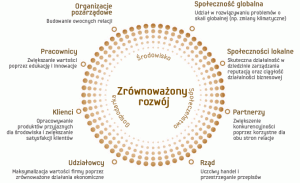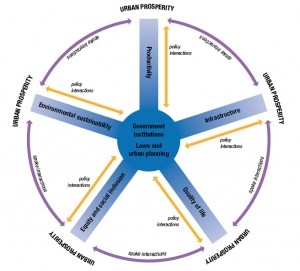“Transforming our World: The 2030 Agenda for Sustainable Development” encompasses a universal, transformative and integrated agenda that heralds an historic turning point for our world.
On 1 January 2016, the 17 Sustainable Development Goals (SDGs) of the 2030 Agenda for Sustainable Development — adopted by world leaders in September 2015 at an historic UN Summit — officially came into force. Over the next fifteen years, with these new Goals that universally apply to all, countries will mobilize efforts to end all forms of poverty, fight inequalities and tackle climate change.
What is sustainable development?
● Sustainable development has been defined as development that meets the needs of the present without compromising the ability of future generations to meet their own needs.
● Sustainable development calls for concerted efforts towards building an inclusive, sustainable and resilient future for people and planet.
● Sustainable development needs to harmonize three core elements: economic growth, social inclusion and environmental protection. These elements are interconnected and all are crucial for the well-being of individuals and societies.
● Eradicating poverty in all its forms and dimensions is an indispensable requirement for sustainable development. To this end, there must be promotion of sustainable, inclusive and equitable economic growth, creating greater opportunities for all, reducing inequalities, raising basic standards of living, fostering equitable social development and inclusion, and promoting integrated and sustainable management of natural resources and ecosystems.
What are The Sustainable Development Goals (SDGs)?
The Sustainable Development Goals (SDGs), officially known as transforming our world: the 2030 Agenda for Sustainable Development, are an intergovernmental set of aspiration Goals with 169 targets and 17 Goals. The agenda was adopted by 193 United Nations Member States.
How are the Sustainable Development Goals different from the MDGs?
● The 17 Sustainable Development Goals (SDGs) with 169 targets are broader in scope and go further than the MDGs by addressing the root causes of poverty and the universal need for development that works for all people. The goals cover the three dimensions of sustainable development: economic growth, social inclusion and environmental protection.
● Building on the success and momentum of the MDGs, the new global goals cover more ground, with ambitions to address inequalities, economic growth, decent jobs, cities and human settlements, industrialization, oceans, ecosystems, energy, climate change, sustainable consumption and production, peace and justice.
● The new Goals are universal and apply to all countries, whereas the MDGs were intended for action in developing countries only.
● A core feature of the SDGs is their strong focus on means of implementation—the mobilization of financial resources—capacity-building and technology, as well as data and institutions.
● The new Goals recognize that tackling climate change is essential for sustainable development and poverty eradication. SDG 13 aims to promote urgent action to combat climate change and its impacts.
How much will the implementation of this new sustainable development agenda cost?
● The means of implementation—including how to mobilize the financial resources to achieve the sustainable development agenda—are a core feature of the new agenda.
● In order to achieve the Sustainable Development Goals (SDGs), substantial investment will be required, in both developed and developing countries. This agenda will require the mobilization of significant resources—in the trillions of dollars. But these resources already exist. There are far more than enough savings in the world to finance the new agenda. How to direct investment so that it supports sustainable development will be crucial for achieving our Goals.
● Resources need to be mobilized from domestic and international sources, as well as from the public and private sectors.
● Official development assistance is still necessary to help the countries that are most in need, including the least developed countries, to achieve sustainable development.
How will the Sustainable Development Goals be implemented?
● Implementation and success will rely on countries’ own sustainable development policies, plans and programmes, and will be led by countries. The Sustainable Development Goals (SDGs) will be a compass for aligning countries’ plans with their global commitments.
● Nationally owned and country-led sustainable development strategies will require resource mobilization and financing strategies.
How does climate change relate to sustainable development?
• Climate change is already impacting public health, food and water security, migration, peace and security. Climate change, left unchecked, will roll back the development gains we have made over the last decades and will make further gains impossible.
• Investments in sustainable development will help address climate change by reducing greenhouse gas emissions and building climate resilience. Conversely, action on climate change will drive sustainable development.
• Tackling climate change and fostering sustainable development are two mutually reinforcing sides of the same coin; sustainable development cannot be achieved without climate action. Conversely, many of the SDGs are addressing the core drivers of climate change.
How will the Sustainable Development Goals be monitored?
● At the global level, the 17 Sustainable Development Goals (SDGs) and 169 targets of the new agenda will be monitored and reviewed using a set of global indicators. The global indicator framework, to be developed by the Inter Agency and Expert Group on SDG Indicators (IAEA-SDGs), will be agreed on by the UN Statistical Commission by March 2016. The Economic and Social Council and the General Assembly will then adopt these indicators.
● Governments will also develop their own national indicators to assist in monitoring progress made on the goals and targets.
● Chief statisticians from Member States are working on the identification of the targets with the aim to have 2 indicators for each target. There will be approximately 300 indicators for all the targets. Where the targets cover cross-cutting issues, however, the number of indicators may be reduced.
Sustainable Development Goals:
- Poverty – End poverty in all its forms everywhere[21]
- Food – End hunger, achieve food security and improved nutrition and promote sustainable agriculture[22]
- Health – Ensure healthy lives and promote well-being for all at all ages[23]
- Education – Ensure inclusive and equitable quality education and promote lifelong learning opportunities for all[24]
- Women – Achieve gender equality and empower all women and girls[25]
- Water – Ensure availability and sustainable management of water and sanitation for all[26]
- Energy – Ensure access to affordable, reliable, sustainable and modern energy for all[27]
- Economy – Promote sustained, inclusive and sustainable economic growth, full and productive employment and decent work for all[28]
- Infrastructure – Build resilient infrastructure, promote inclusive and sustainable industrialization and foster innovation[29]
- Inequality – Reduce inequality within and among countries[30]
- Habitation – Make cities and human settlements inclusive, safe, resilient and sustainable[31]
- Consumption – Ensure sustainable consumption and production patterns[32]
- Climate – Take urgent action to combat climate change and its impacts[33]
- Marine-ecosystems – Conserve and sustainably use the oceans, seas and marine resources for sustainable development[34]
- Ecosystems – Protect, restore and promote sustainable use of terrestrial ecosystems, sustainably manage forests, combat desertification, and halt and reverse land degradation and halt biodiversity loss[35]
- Institutions – Promote peaceful and inclusive societies for sustainable development, provide access to justice for all and build effective, accountable and inclusive institutions at all levels[36]
- Sustainability – Strengthen the means of implementation and revitalize the global partnership for sustainable development[37]







Leave a Reply
You must be logged in to post a comment.